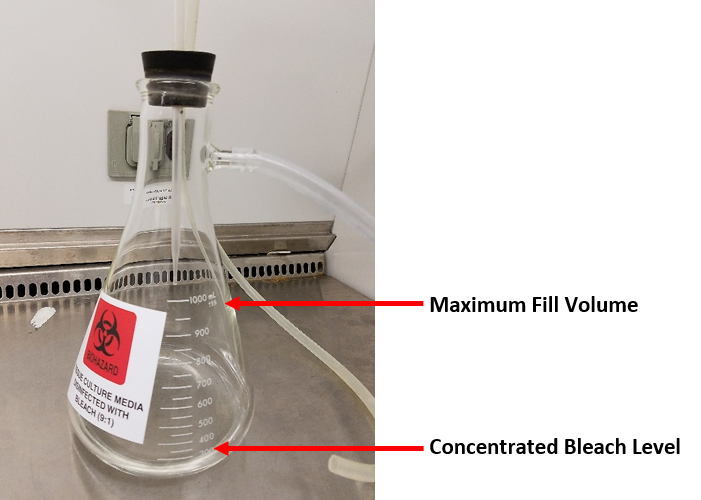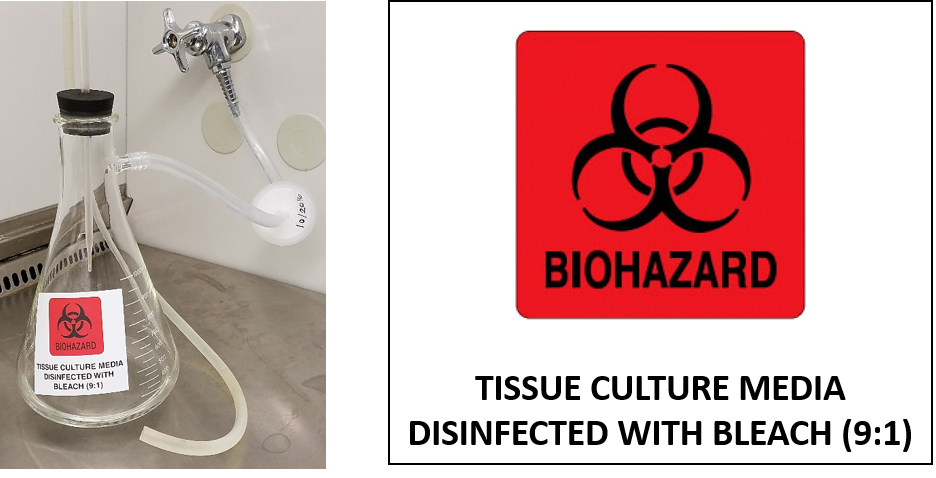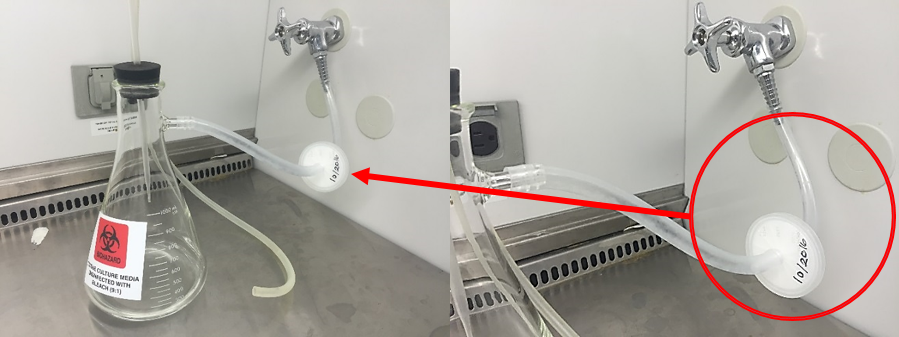Biosafety: How to Disinfect Tissue Culture Media in Vacuum Flasks
Use this standard operating procedure for disinfecting tissue culture media as required by San Diego County.
Materials
Utilize appropriate personal protective equipment, engineering controls, and the following materials to assemble a vacuum flask and ensure proper disinfection and disposal of tissue culture wastes:
- Vacuum flasks (preferably plastic, to avoid breaking/spilling)
- Thick-walled plastic tubing (to prevent tubing collapse)
- Glass or plastic tube
- Rubber stopper
- HEPA filter
For chemical disinfection of liquid biohazardous waste, the only university-wide approved disinfectant for UC San Diego is bleach (1 part bleach to 9 parts liquid waste, 30 minute contact time, followed by sewering). If your laboratory wishes to inquire about the use of alternative disinfectants to inactivate liquid biohazardous waste, please send an email with the following information:
- Material to be disinfected
- Chemical to be used
- Concentration of chemical
- Contact time
- Disposal method (sewering, hazardous waste pickup)
You will receive a response within 5 working days regarding approval.
1. Prepare the primary vacuum flask with bleach

- Vacuum flasks should be prepared with bleach prior to adding tissue culture media.
- To disinfect the liquid waste, add a sufficient amount of household bleach so as to create a ≥10% final bleach concentration. For example, a mixture may be made by adding 100 milliliters of bleach for 900 ml of liquid waste.
- Maximum collection volume should be no more than two-thirds full.
- When not maintained inside a biosafety cabinet (BSC), vacuum flasks should be stored in a non-breakable and leak-proof secondary container having a volume sufficient to hold liquid contents.
2. Label the flask

Label the flask with the following:
- Apply Biohazard label (To request a Biohazard label, e-mail ehsrap@ucsd.edu and apply a Contents label indicating “Tissue culture media disinfected with bleach 9:1” (Use these printable waste labels (Word file) to affix on flask.)
Or
- Apply a Combined Biohazard and Contents label indicating “Tissue culture media disinfected with bleach 9:1” (Use these printable waste labels (Word File) to affix on flask. These can be printed on Avery labels 3 1/3 in. x 4 in.)
3. Protect the vacuum system with a filter

- Insert an in-line hydrophobic HEPA filter before the vacuum outlet for flasks connected to the building vacuum system.
- For individual vacuum pumps a HEPA filter is not required; however, due to the possibility of contamination of the vacuum pump, a HEPA filter or additional vacuum flask trap is recommended.
- Vacuum lines should be turned off when not in use.
- Filters must be replaced as needed—at a minimum, annually and when there is any evidence of deficiencies (e.g. filter blockage, failure, wetness). When changing out filters, dispose of them as regulated medical waste, hazardous chemical waste, or radiological waste, as appropriate.
Note: The addition of a glass or plastic tube from the rubber stopper into the solution in flask minimizes the generation of aerosols.
4. Empty the flask into the laboratory sink
- Discontinue use of vacuum flask when it is two-thirds full.
- Add an additional volume of household bleach required to achieve a final concentration of ≥10% bleach, and leave at room temperature for 30 minutes to ensure sufficient contact time with disinfectant.
- Empty the flask (treated liquid waste) into the laboratory sink.
- Use care when pouring into the lab sink to minimize splashing and always use a lab coat, gloves, and splash goggles or safety glasses (a face shield is optional).
- Thoroughly rinse the sink following waste discharge.
- Flasks should be emptied and cleaned weekly, or when full, whichever comes first, to prevent overflow.
Precautions
- Liquid waste may also be autoclaved and then disposed of via the sink.
- If you autoclave your waste, you should not pre-treat with bleach. Bleach is not safe to autoclave.
- Hazardous waste cannot be disposed of down the drain. If there are any chemical constituents, other than the disinfectant, or radiological constituents that are not acceptable for drain disposal, the tissue culture waste must be managed as a hazardous waste in accordance with the UC San Diego hazardous waste disposal procedures.